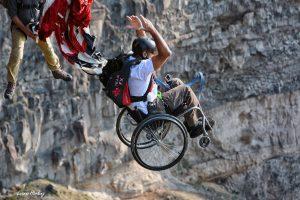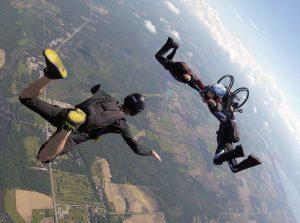Scars and BASE jumping – Returning to the scene of the accident
Extreme sports are a way of life for Canadian native Lonnie Bissonnette. From bobsledding to BASE jumping, the thrill of the sport outweighs the obvious dangers.
But on July 19, 2004, Bissonnette was at the Perrine Bridge in Idaho preparing for his 1,100th jump.
“It’s legal to jump there any day,” says Bissonnette. “We’d been there for a while, and I was keeping track of my jumps and told my friends, “Hey, this will be my 1,100th BASE jump. We should do something special to remember it.”

His group decided to set a new Canadian record for the most people jumping off the bridge at once and break the old record of six. They had seven Canadians.
Adding to the jump, Bissonnette planned to do four backflips while jumping with everyone else. This would be his final able-bodied jump.
“I didn’t take enough time to get ready,” he recalls. “I was busy organizing the jump and had too much on my mind. Looking back, I see my mistake. As soon as I jumped, I knew I’d messed up. I was flipping too slowly.”
His options to recover the jump were limited — do only two flips and deploy his chute early. But doing that would endanger the other jumpers and potentially send Bissonnette into their airspace, entangling the group.
“I had to do all four,” Bissonnette says. “That last flip, I had rushed it and my legs hadn’t quite finished that last rotation. The pilot chute, which is the miniature parachute, came out and tangled around my leg, hanging me upside down.”
Bissonnette tootsie-rolled into the Snake River at roughly 70 mph and sustained a C-3 incomplete spinal-cord injury.
Fast-forward 20 years and Bissonnette, nearing 60 years old, finds himself back in Jerome, Idaho, looking down into the abyss of the Snake River atop the Perrine Memorial Bridge, preparing to jump … again.
“I got a call from a production company in Australia that wanted to film me going back to the bridge because it would be 20 years coming up,” says Bissonnette. “I agreed to go and do that, and we went back and jumped the bridge again, but this time with the wheelchair.”
Bissonnette says he wasn’t too worried about the jump. He had done many BASE jumps since his accident, using his wheelchair. He’s proud to be the first and only paraplegic BASE jumper to jump off all four types of objects: buildings, antennas, spans and earth. He’s trying to encourage other paraplegic jumpers, but so far, no one else has completed all four.

“But the one thing that I didn’t quite plan on was the platform to roll off was a lot smaller than I thought it was going to be,” says Bissonnette. “I barely had enough room to get my chair on it, turn and then roll off. So, there definitely was an ‘oh shit’ moment for sure.”
That wasn’t the only pucker-moment for Bissonnette on the other side of the bridge railing. The adaptive platform he was on, because of his combined body and chair weight, had a bit of a tilt and was rolling him off the edge before he was ready to jump.
“So, in the video, all you hear me say is go,” says Bissonnette. “It was supposed to be a countdown, but once I got ready, I was like, ah, I’m going, whether I like it or not.”
Bissonnette’s preparation for jumping is now much more complex. In the past, he could just grab his gear and go. But with his wheelchair, things are different.
“I had to design a strap system that could keep me in the chair,” he says. “The strap needed to be very similar to the connection point that we use for the parachute. It needs to have a very quick cutaway system in case, you know, for whatever reason, I’m tumbling out of control. I don’t want to open the parachute while I’m tumbling because the chair has so many snag points that I’d definitely be going into the ground with nothing out again because I’d be all tangled up.”
Bissonnette has engineered several other safety and deployment features into his jump system, considering his specific needs, including the wheelchair itself.
“Because I don’t have the core strength, I needed a strap that would hold the foot plate up and hold my feet up, otherwise they would just angle downward and I would just plow into the ground,” he says. “I did a bunch of testing, and we’ve got a strap that I adjust, so that I’m in a bit of a wheelie so that when I land, I’m in that little bit of a wheelie, you know, and that’s the way you want to go.”
On top of that, Bissonnette needed a parachute system for the wheelchair itself.
“If I had to get rid of the chair, for whatever reason, I didn’t want the chair to just plummet to the ground and possibly hit some kid,” Bissonnette says. “So, you know, the chair, if it gets damaged, it’s not a big deal, it’s a piece of equipment. But if the chair were to hit some kid and kill them, then you know that would be it. I wouldn’t be able to live with myself.”
Bissonnette finds a lot of joy in BASE jumping. He thinks people do many cool things in the sport.
“As someone who uses a wheelchair, I sometimes find it hard to accept that I can’t do everything alone,” says Bissonnette. “I try to be as independent as possible and don’t want to feel useless. But there are times when I need help from my friends. Without them, I know I couldn’t have done half the things I’ve accomplished. Their help makes my adventures possible.”
Keep an eye out for a Netflix documentary-type release of Bissonnette’s jump later this year.(which is posted below)
Video of Lonnie Bissonnette’s jump over the Snake River in Idaho. (Video provided by Bissonnette).